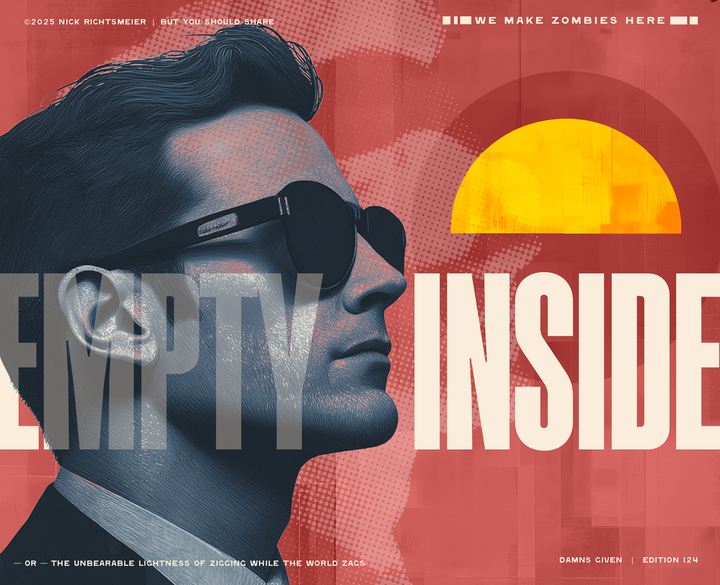The next great competitive advantage
The turn-of-the-millennium competitive advantages are waning. The Venture Capital bubble in Silicon Valley is resetting our view of where to find value. The gas that ran the Digital Revolution is on empty. Businesses need to define what happens next.

How Intellectual Capital and it's Marketing Partner "Thought Leadership" are the new engine of differentiation
The cultural phenomenon, Rent, announced the end of the 20th century with these words:
When you’re living in America
At the end of the Millennium
You’re what you own.
Not exactly a stirring endorsement of one of the most expansive economies ever created by human society. But it raises a question, now a quarter-century later, what do we really own? And what is it worth?
It turns out that the Digital Revolution did real carnage to what was once an “ownership economy,” stripping asset ownership as the primary creator of wealth. This has come with pros and cons, but regardless we now stand in the Late-Stage of the Digital Revolution.
Businesses won’t win by owning real estate and fancy machines or server farms. By some estimations they won’t even win with cash (as the Silicon Valley Recession has shown). But they may just win with something else, the next great competitive advantage, Intellectual Capital.

Venture Capital changed the definition of value.
The rise of Venture Capital (VC) has had a significant impact on how companies are valued. Prior to the modern rise of VC, companies were often valued based on their tangible assets, such as property and equipment, as well as their financial performance: profits and revenue.
However, with the rise of VC as a major player in picking winners and losers, that shifted towards valuing companies based on their potential for growth and future success. This very ethos of paying big dollars for potential is what created Silicon Valley as we know it.
But potential is so subjective. All the more so today as we businesses are left to make big bets on an increasingly volatile future. How should that potential be measured? If we frame “potential for growth” as “competitive advantage” then the the challenges of the current moment become clear:
The turn-of-the-millennium competitive advantages are waning. The Venture Capital bubble in Silicon Valley is resetting our view of where to find value. And companies can’t run on fumes hoping for multi-million dollar infusions to take them to the next level.
The gas that ran the Digital Revolution is on empty. To understand where to go next, we’ve got to know how we got here.
Late-Stage Digital: The waning of a Revolution
Revolutions exist to exploit inefficiencies out of an aging economic society. The turn of the 20th century reflected the Industrial revolution a transformation in the western economies from agricultural economies. The last 50 years have represented the digital revolution and the end of industry as we know it in the 1900s.
Comparing these two economic revolutions and what they exploit shows us that we are nearing the calcification of the digital revolution’s effects. A time period where all the obvious inefficiencies have been devoured, and companies will have to prove value a in new and unfamiliar ways.
Stage 1: Technological Innovation – Exploits the foundational inefficiency
INDUSTRIAL: Combustion Engine
DIGITAL: The Computer
Stage 2: Accelerated Productivity – Exploits the constructive inefficiency
INDUSTRIAL: Factories
DIGITAL: OS, Software, Networked Offices
Stage 3: Diversified technology – Exploits that innovation inefficiency
INDUSTRIAL: Machine tools - lathes, construction equipment, etc.
DIGITAL: Digital Tools – Telecom and personal devices
Stage 4: Accelerated Connectivity – Exploits the collaborative inefficiency
INDUSTRIAL: Expanded Railroad and Highway system
DIGITAL: The Internet
Stage 5: Reorganized Relationships – Exploits the social inefficiency
INDUSTRIAL: Expansion of Cities and Suburbs
DIGITAL: Social networks and video technology
Stage 6: Transformation of Value – Formalizes the revolution
INDUSTRIAL: Speed, Scale and Uniformity
DIGITAL: Data, Access, and Information
We can see from the modeling above that the innovation curve of the Digital Revolution is reaching its late stage. The majority of the inefficiencies that create capital and opportunity from the introduction of digital have been squeezed out. The American economy, as most do, took several decades to metabolize the Industrial Revolution, absorb its social impacts, and redistribute capital to prepare for the next great leap in opportunity.
The signs of such a settling may seem very familiar to where we are today. In such times of latency and absorption, new forms of value creation emerge. Less disruptive than their predecessors, they tend to create leadership in a more human form. Enter Intellectual Capital.

What is Intellectual Capital?
Intellectual capital refers to the intangible assets of an organization that contribute to its value and competitive advantage. The Coprorate Finance Institute frames it as the sum of three types:
- Human Capital: The skills and knowledge of the organization's employees. What we call “Wisdom.”
- Relational Capital: All the valuable relationships that an organization maintains with customers, suppliers, partners, clients, and other external entities. What we call “Trust.”
- Structural capital: The processes, systems and internal synergies that produce results). What we call “Culture.”
Unlike traditional forms of capital, such as physical assets or financial capital, Intellectual Capital is not easily transferred or replicated, making it a valuable and unique resource for organizations. It creates unfair advantages and long-term competitive barriers to entry. It is the fodder of the infamous “category creators,” but moreso it is the most likely engine of growth for the remainder of the 2020s.
Revolutions make turn their innovations into commodities. Cheapening the exact thing that created the economic growth. Now that knowledge is basically free, leadership has to come from somewhere else.
After a Revolution, everything is cheap
This seems a big claim as the country (at the time of publication) is metabolizing near-record inflation. And yet, when viewed structurally, the cheap access to data, information, speed, and connectivity we have today would have been unimaginable even just 20 years ago.
With the rise of generative AI like Chat GPT and Bard AI, you can access aggregated versions of the internet’s troves of information for free, at the touch of a button. Gone is the competitive adavantge of storing obvious insights on your website in the hopes of getting Google to point your way.
The Platforms that digital built: Meta, Amazon, Google, and Microsoft will continue to do what they’ve been doing, but at a much more accelerated pace: degrade their connectivity to other places on the internet, scrape accessible data wherever it is available, and use AI and ML to subvert any reason you might have to leave the Platform. Instead of being gateways to the rest of the world, they will become walled gardens, built to keep you in.
The platforms are not just thinking for us. They are telling us what to think. The obvious information is being digested and delivered in increasingly tight packages. Everything we were supposed to know is freely available.
30 years ago GI Joe taught GenXers that “knowing was half the battle.” Today the slogan shifts: “Knowings is the cheap and easy part.” So after knowing, what’s left?

The three investments of Intellectual Capital
What remains is the power of human intellect and connectivity. The ability to synergize knowledge into the production of Wisdom. The ability to empathize experience into the production of Trust. And the ability to harmonize inspiration in the production of Culture.
Organizations that produce strength in these three areas will have the post-digital competitive advantage. With the shift in value creation, how businesses invest has to radically change in response.
Invest in Wisdom: The Prophet
Organizations cannot just get smarter. They must become synthesis engines where the knowledge readily accessible across disciplines is integrated into their way of doing businesses. Leaders able to integrate advances in neuroscience, sociology, AI, and macroeconomics will be in a position to lead.
By bringing together multiple intelligences into your leadership team—emotional, rational, economic, social, spatial—an organization’s ability to read the tea leaves of the current moment and pivot with agility advances dramtically. We call this wisdom leadership the Prophet—able to wisely predict the scope of risk and opportunity in the marketplace’s next mile.
Invest in Trust: The Neighbor
Today’s healthy, generative organizations understand that they aren’t an economic engine producing saleable widgets. They are a network of interlocking communities. Leaders who understand that build trust-driven value engines building collaborations across their industry, their geographic homes, their employee networks, and their buying and pre-buying groups.
The Neighbor builds a nearly impenetrable competitive wall around their success by ironically doing the opposite everywhere else: tearing down walls between groups and individuals. They see all as prospective collaborators.
Invest in Culture: The Muse
Culture is when shared human agency produces a whole that is greater than the sum of its parts. Culture isn’t a place, it’s a force. And as we leave the digital revolution and we realize anew that all problems are human problems, the great organizations will realize that all solutions (that endure) are human solutions. Organizations that invest, not just “in their people” but in the repeatable systems, rhythms, experiences and structures that stir generativity, are the only ones that have the capacity to lead.
They are the Muses of the yet-to-emerge economy, masters of inspiration. Inspiration isn’t a ball of warm fuzzies made by a dog video on TikTok. The old word means our true selves are awakened and we shed the mask of just getting by. Inspiration is both powerful and dangerous, particularly to the tired guardians of the status quo.
Inspiration sees the forthcoming inefficiencies in the way things are, often standing at the trigger of the next great revolution.
In Summary
Intellectual Capital, like so many words we use in business, sounds hollower and more stoic than it really is. As exemplified above, it is the next great competitive edge. Businesses that harness it are not just responsive to market changes but creators of them, driving innovation.



